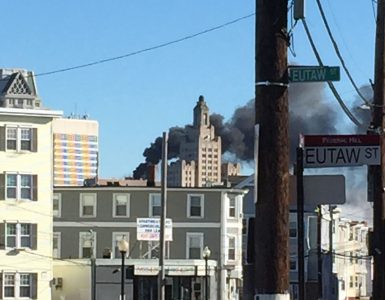
Photo from WPRI
Reports are coming in from around the region of roof collapses caused by the combination of previous heavy snow and large amounts of rain, including a collapsed roof yesterday in Pawtucket.
The City of Providence has issued a Public Service Announcement about the risk:
***PUBLIC SERVICE ANNOUNCEMENT***
A MESSAGE FROM COLONEL PETER GAYNOR, DIRECTOR OF PROVIDENCE EMERGENCY MANAGEMENT AGENCY
ROOF COLLAPSE CONTINUES TO BE OF HIGH CONCERN IN PROVIDENCE
The amount of recent snowfall that is piling up could weaken roof structure and cause a collapse. Homeowners and business owners should be mindful of the risk of personal injury to themselves and occupants before removing snow from roofs. A contractor could be helpful in assessing the need for snow removal. Most tree removal companies will do snow removal from roofs.
WHAT TO LOOK FOR
Be on the alert for large accumulating snow build-up or snowdrifts on your roofs. If roof snow can be removed with the use of a snow rake (available at most hardware stores), do so. Use caution, as metal snow rakes conduct electricity if they come into contact with a power line.WARNING SIGNS OF A POTENTIAL ROOF COLLAPSE
Prior to a roof collapse, buildings generally exhibit signs that the roof is in distress and action should be taken to mitigate a roof collapse. The following are some of the symptoms that have been reported prior to roof failure:
- Sagging roof steel – visually deformed
- Severe roof leaks
- Cracked or split wood members
- Bends or ripples in metal supports
- Cracks in walls or masonry
- Cracks in welds of steel construction
- Sheared off screws from steel frames
- Sprinkler heads pushed down below ceiling tiles
- Water in ponds where it never has not formed ponds before
- Doors that pop open
- Doors or windows that are difficult to open
- Bowed utility pipes or conduit attached at ceiling
- Creaking, cracking or popping sounds
TIPS FOR SNOW REMOVAL FROM ROOFS
- Try to avoid working from ladders, as ladder rungs tend to ice up. Snow and ice collect on boot soles, and metal ladders.
- Flat roofs can be shoveled clear, but only if it is determined that the roof is safe to stand upon. Exercise care when on the roof to avoid potentially dangerous falls.
- Flat roof drainage systems should be kept clear to minimize the risk of excess roof ponding in the event of subsequent heavy rainfall or melting.
- Large icicles can form on roof overhangs, but do not necessarily mean ice damming is occurring. Icicles overhanging doorways and walkways can be dangerous and should be carefully removed.
- All of the mentioned actions should only be performed by able-bodied adults, as the snow is heavy, and roofs and other surfaces may be slippery. Protective headgear and eye protection is recommended.
WHAT TO DO IF YOU SUSPECT AN IMMINENT ROOF COLLAPSE
- Evacuate the Building
- Call 911
Helpful Links: weather.thefuntimesguide.com





Whether the snowfall is “heavy, wet snow” or “light, dry snow” may not matter. I think many of the people and agencies specializing in this problem know this, but anyway, here’s my point: If we have a big snowfall of “light, dry snow” we may be at risk after a few days as the weather warms up and the relative humidity in the air increases. So, whether it rains after the snowfall or not, an increase in the relative humidity after a “light, dry snowfall” may cause the roof snowload to gain weight drastically, because the dry snow may absorb atmospheric humidity like a dry sponge. After a few days, the pounds per cubic foot of “dry snow” may increase to that of “wet snow,” or from about 5 lbs. per cubic foot of snow, to about 31 lbs. per cubic foot of snow. This is a drastic increase– I am not sure how often this sort of thing may occur, but I thought I should mention it as a possible hazard after the “dry snow” has fallen; if the roof has not collapsed yet, it may be that the snow is just beginning to gain weight via absorbing atmospheric humidity. So the danger may increase gradually after a dry snowfall even if there is no subsequent rainfall and no more snow. This would explain a lot of “delayed roof collapses” that catch people by surprise after the major hazard seems to have passed (not snowing, sleeting, or raining anymore). (One commenter on another site mentioned that the roof snow in one case was being cleared off by using water hoses!) This is very dangerous because the snow then absorbs water like crazy and could cause roof collapse very quickly. Because of this delay, when a roof snowload is in the process of melting off during sunny days, the snowload nevertheless could still be increasing in weight by absorbing atmospheric humidity, especially if the relative humidity goes very high after a major snowstorm and subsequent thaw.